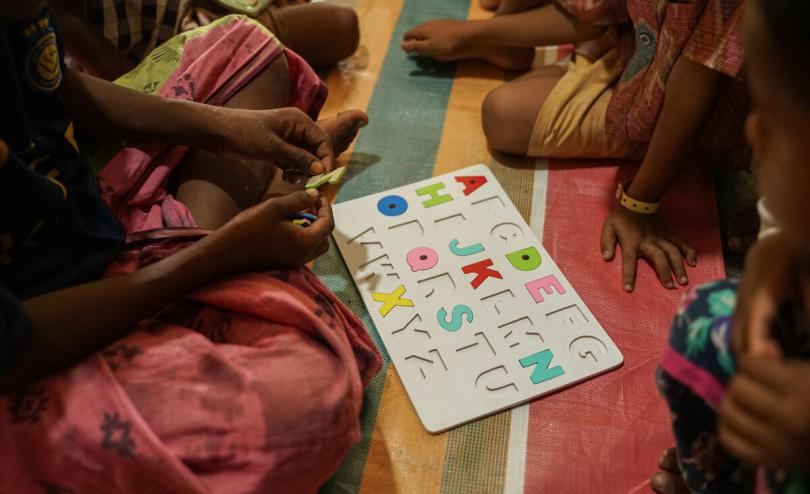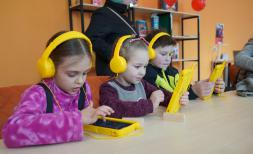Spike in arrivals of unaccompanied Rohingya children in Indonesia highlights increasing desperation – Save the Children

A group of Rohingya children play puzzles in a session carried out by the Geutanyoe Foundation, Save the Children's local partner, in a camp in Aceh, Indonesia. March 07, 2024. Photo credit: Purba Wirastama / Save the Children.
JAKARTA, 21 March 2024 - About 250 unaccompanied Rohingya children[1], some as young as 11, arrived in Indonesia in the last three months of 2023, a 78 percent increase compared to arrivals throughout the rest of that year[2], said Save the Children.
The children’s rights organization analyzed figures from two quarterly reports from the UNHCR which showed a worrying increase in the number of children taking the perilous journey on their own. Last year, some 4,500 Rohingya[3] refugees, the majority from Bangladesh, embarked on sea journeys in search of better opportunities and safety, which marked a 22 % increase from 2022. Among the new arrivals last year, 37 %, or about 1,670, were children including the 250 unaccompanied children who often face elevated risks including from abduction, trafficking, exploitation, and physical and sexual violence.[4]
Rashid*, 11, brought just a few biscuits and some drinking water in a small bag for his 5,000-kilometer (3,000 miles) sea journey from Bangladesh to Indonesia. He made it to Aceh, Indonesia, in November after 12 days at sea but misses the family he left behind including a mother and two siblings.
“The only thing I want to meet is my family,” he said.
"I remember some messages my father and mother told me through my mobile: take care of yourself, live in a quiet place ... attend school, and eat on time."
Increasingly desperate Rohingya families living in camps in Bangladesh are also being driven to high-risk sea journeys due to violence and security incidents[5]. Some, like 30-year-old mother of three Fatima* say a lack of job opportunities and education, as well growing concerns over safety in the camps, pushed them to escape Bangladesh in search of safety and a better future for their children.
“I want to be resettled to a country where my children can learn and live safely,” she said.
Because they are stateless, there is no legal pathway that allows Rohingya refugees to move around freely. Those looking for a better life are often forced to take perilous boat journeys offered by smugglers.[6] More than 60 % of new arrivals last year landed in Indonesia, while others disembarked elsewhere in Southeast Asia or were intercepted.
Syifa*, 11, is one of those who made the journey this year along with her parents and three siblings. The family were at sea for one and a half weeks before they reached the shores of Indonesia.
“I was so scared, I could only see the sea,” said Syifa, her voice trembling. “But when I saw an island, I was so happy,” she said.
Bangladesh and Indonesia are not signatories to the 1951 UN Convention on Refugees but have been known for providing a haven to Rohingya refugees even when other countries in the region turned them away.
In recent months, however, Rohingya children and their families have become the target of both physical and online violence in Indonesia, driven by a campaign of misinformation and hate.[7]
Dessy Kurwiany Ukar, interim CEO of Save the Children Indonesia, said:
“The presence of unaccompanied children in Aceh is alarming and suggests that Rohingya families are desperate enough to send their children away in search of a better life. Indonesia’s government should continue to allow boats to disembark and provide ongoing support to Rohingya refugees but other countries across the region should also share the responsibility of protecting and assisting the Rohingya, including unaccompanied children.”
Save the Children is also calling on governments to provide Rohingya refugees with safe and legal pathways to seek asylum and access opportunities to improve their lives, including exploring options for large-scale third country resettlement, and for Bangladesh and regional governments to expand formal employment and educational opportunities for Rohingya refugees, in support of medium and long-term solutions for Rohingya communities.
Cox’s Bazar is home to the largest refugee settlement in the world, with almost 1 million Rohingya refugees. Save the Children is one of the leading international NGOs working in the Cox’s Bazar camps in Bangladesh. It has reached about 600,000 Rohingya refugees, including more than 320,000 children, since the response began in 2017.
In collaboration with local partner Geutanyo Foundation, Save the Children Indonesia has been responding to this humanitarian crisis since November 2023 by providing aid in two camps in Aceh, reaching a total of 937 people, of whom 346 are children.
Save the Children has set up child-friendly spaces in Aceh where children can play, learn, and recover. To ensure their hygiene needs are met, we have also distributed about 400 hygiene kits to children and families in two camps. Working with local authorities and the Geutanyo Foundation, Save the Children has also conducted activities to help foster acceptance of Rohingya arrivals from the local community.
ENDS
*******************************************************************************************************************
[1] UNHCR REGIONAL BUREAU FOR ASIA AND PACIFIC (RBAP)
ROHINGYA REFUGEES FLEEING OVER LAND AND SEA - QUARTERLY UPDATE
as of 31 December 2023
[2] https://data.unhcr.org/en/documents/details/103909
[3] https://data.unhcr.org/en/situations/myanmar#powerbi
[4] https://resourcecentre.savethechildren.net/pdf/tools-web-2017-0322.pdf/
[6] https://www.unhcr.org/id/en/54315-14-facts-on-rohingya-refugees.html
[7] Drone Emprit: https://pers.droneemprit.id/tren-dan-volume/
*Name changed to protect anonymity.
For further enquiries please contact:
Amy Lefevre, Global Media Manager, Asia: Amy.Lefevre@savethechildren.org
Our media out of hours (BST) contact is media@savethechildren.org.uk / +44(0)7831 650409
Please also check our Twitter account @Save_GlobalNews for news alerts, quotes, statements, and location Vlogs.




